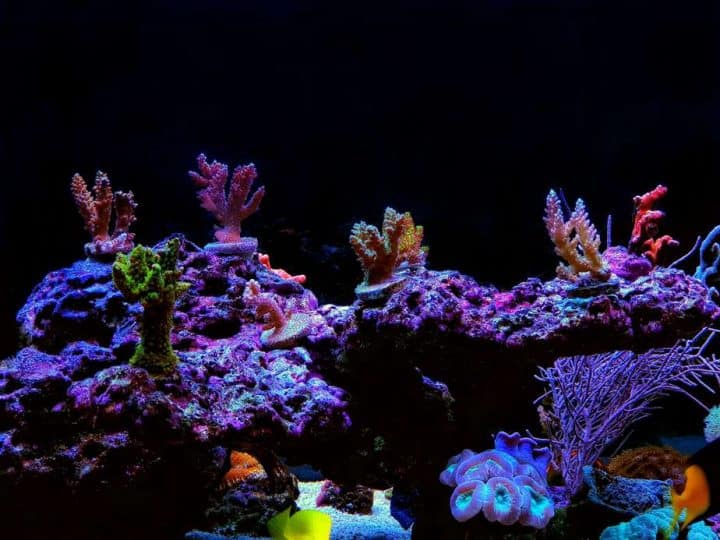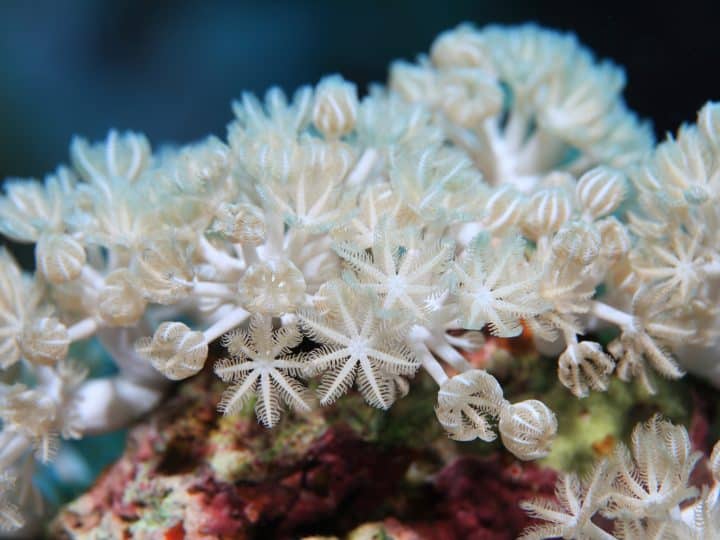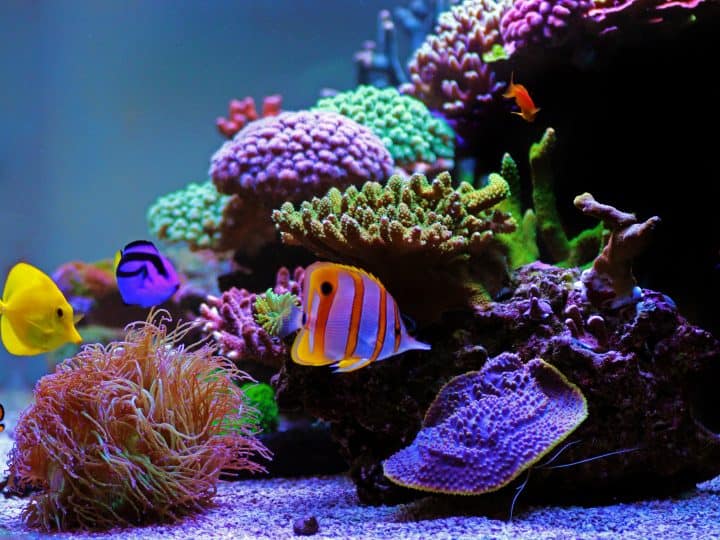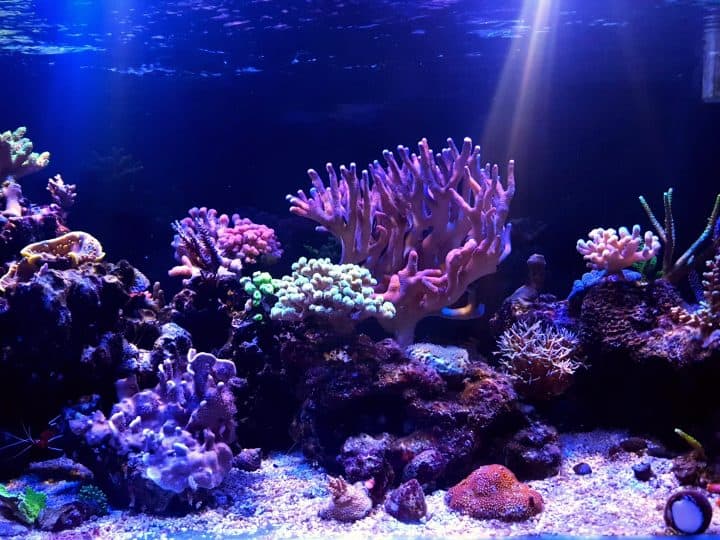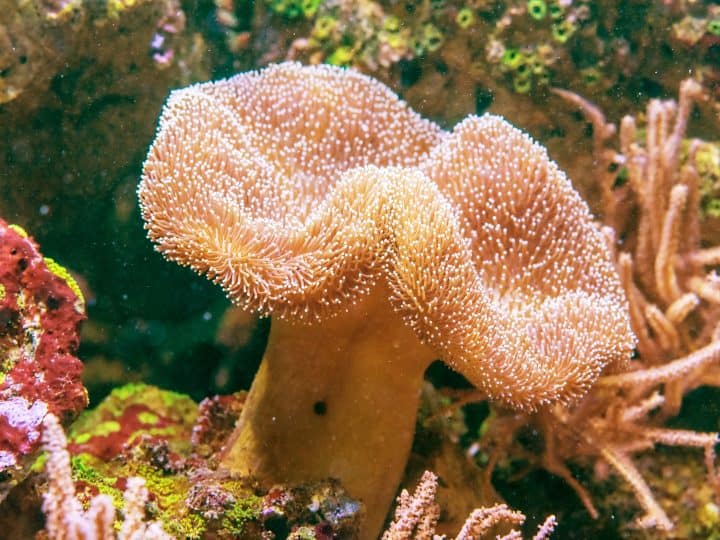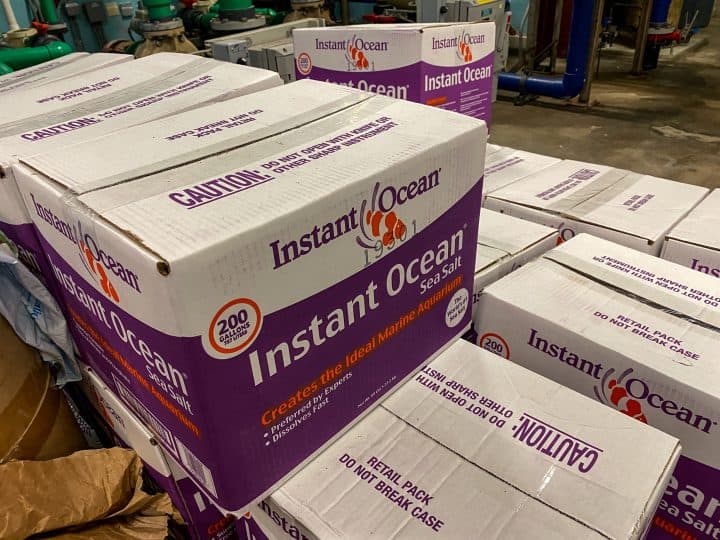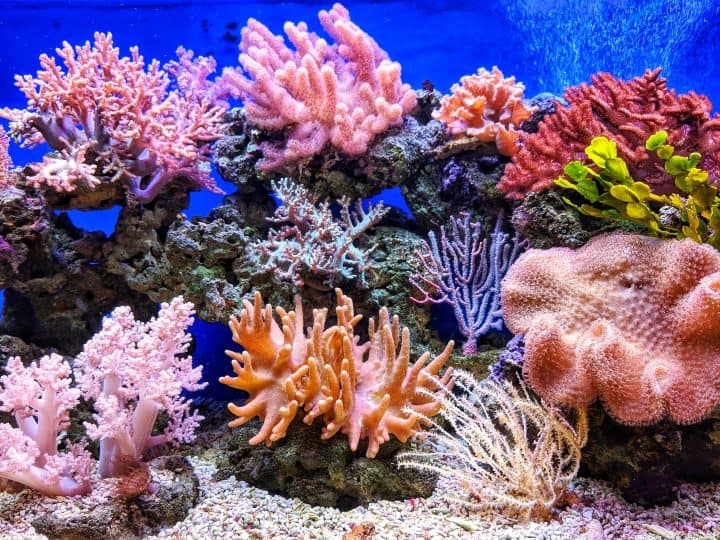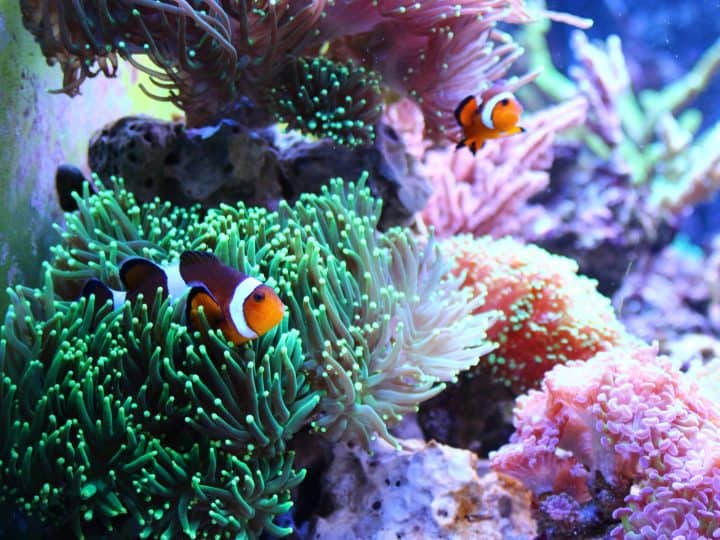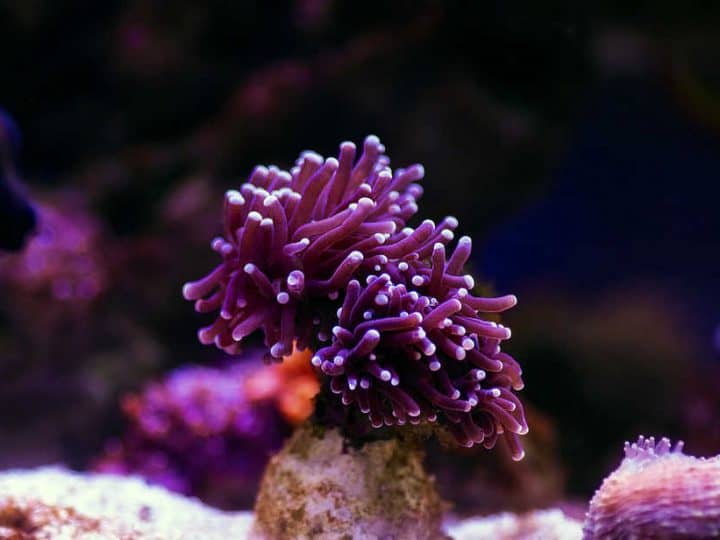Every enthusiast aquarist at some point will want to have corals in their aquarium at some point. Growing corals take a lot of preparation and understanding of the process, growing them honestly is kind of hard!
Growing coral isn’t that difficult. However, as a beginner, you have to choose the ones that take the least effort. Corals are fairly versatile in terms of the environment, which means they can adapt to slight changes in the parameter. The only thing you need to focus on is any drastic changes in the water. Corals don’t take kindly to these changes.
Choosing the right coral can be confusing, so is buying the perfect tank. Setting up the tank, balancing the parameters, placement inside the tank, etc. requires precise guidance. In this article, I am going to talk about all of these in detail. This write-up aims to be the one-stop solution for any aquarists wondering how to grow corals in aquariums.
Choosing the Right Tank
Before you buy anything, you have to buy a tank. Just like most products that are necessary to keep fish and corals, you’ll be blown away by all the different tank options that are out there. It’s important that you know what to look for because otherwise you risk buying an unsuitable tank while spending a big sum of money at the same time.
Therefore it’s important to talk about the requirements of the tank before we can dive into the list of suitable corals for beginners.
Correct size to keep corals
The size is very crucial for coral reefs. While it’s certainly possible to keep corals in smaller tanks, I recommend choosing the largest tank that you can fit within your budget. I know this makes me sound like a salesman, but there’s a good reason for this recommendation: in larger bodies of water finding and maintaining a balanced environment is way easier.
Buy the biggest tank you could find matching your budget. As a beginner, you will grow corals that are easy to care for and maintain, these corals should be highly adaptive. But as I said earlier, corals don’t like drastic changes in the environment and water parameters.
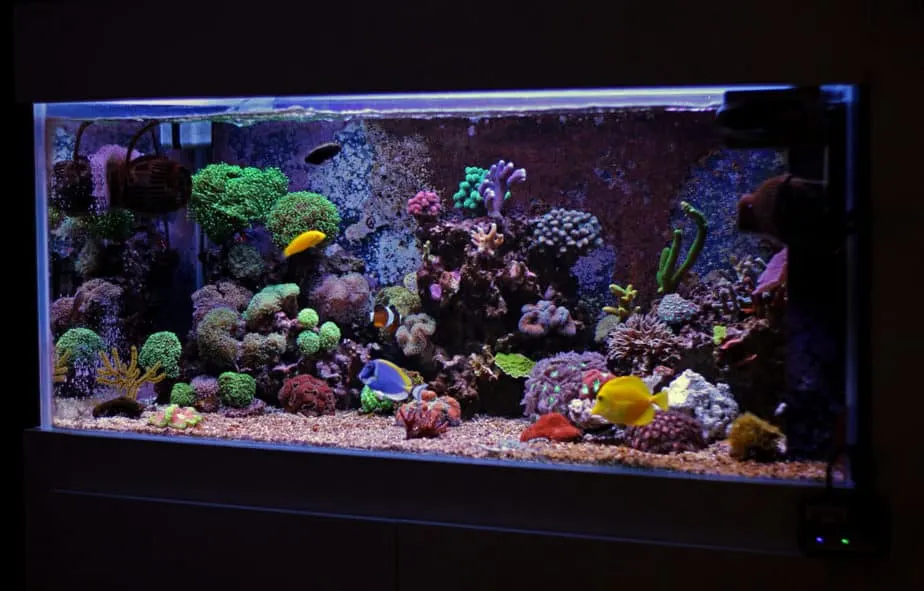
Out in the ocean, the amount of water is humongous. It will take years of massive pollution to even dent the water parameters. See where I am going? If the tank you are using is small, any slight mishap shall change the entire tank ecosystem drastically. A power outage or even a drop of coffee could cause a disaster.
You will see in various forums where people talk about buying smaller tanks as they are easy to make quick adjustments in case things go south. But making those tiny adjustments requires years of expertise and experience. So, stick to the bigger tanks. Also, go for renowned brands as they usually offer complete kits that include the right equipment.
The recommend tank material is acrylic
When it comes to materials, there are only two and you probably already know this. The tank can be made out of glass or acrylic. I recommend an acrylic aquarium with an overflow and a sump. I’ve written an analysis between glass and acrylic tanks, which you can use to make up your own mind. You can read it here.
A sump is a second tank that’s hidden underneath your main aquarium. The sump houses all equipment and filtration, which allows you to hide everything beautifully. Adding a sump also increase the total amount of water in the system which provides better stability for your corals.
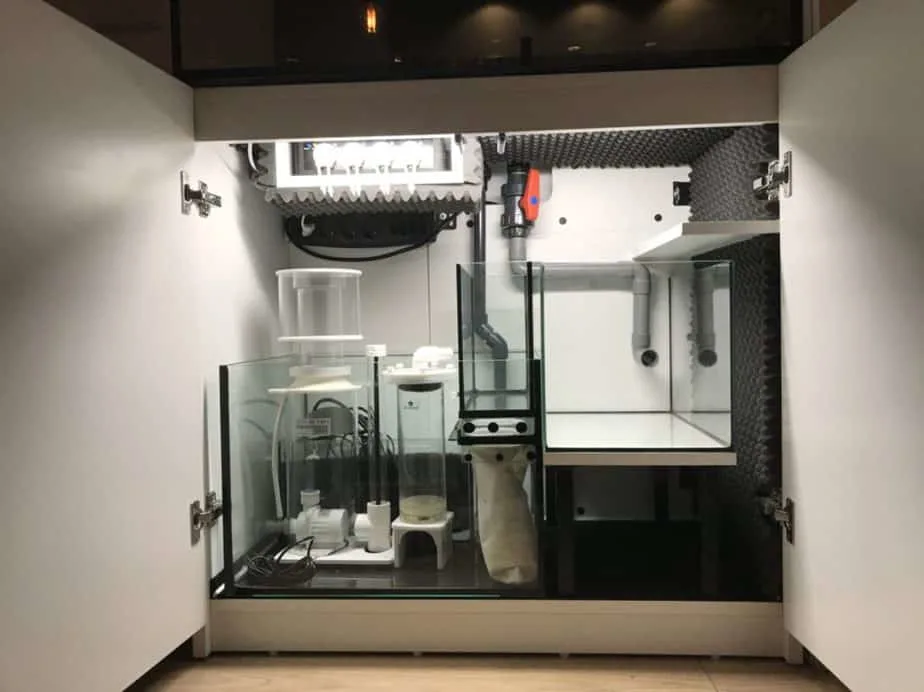
Glass tanks are also an option. There’re some beautiful glass tanks on the market. The reason why I recommend acrylic for growing corals is because acrylic is easier to drill holes in. If you’re not buying a pre-built set and you’d like to add an overflow so you can install a sump, acrylic is the easiest option. You can also drill a hole in glass, but this is more difficult: it requires a diamond drill and you risk shattering the tank.
Tank Setup for Growing Corals
Now that you know what to look for when buying the tank, let’s talk about things like proper equipment. I promise we’ll get to the coral-stuff but if you can not provide the proper parameters and environment in general you will not be able to grow corals.
Setting up the tank in the right way with the right equipment is the key because 90 percent of your labor will go into this part of the process. It consists of rock placement, pouring the water, setting up proper lighting, checking and maintaining correct water parameters and adding the right amount of flow. All of this may sound complex, but I’m here to make it easy for you. Just keep on reading.
Salt Water
Let’s tick off some of the easier aspects of growing corals first before we come to stuff like lighting. When it comes to saltwater, the actual water you’ll put in the aquarium, there are only two option. You can buy readymade pre-mixed saltwater from stores or you can invest in an RODI unit to make your own.
For your first tank I would recommend buying the aquarium water from your local fish store. You’ll be sure that you got the right amount of salinity, which is important.
Making the saltwater yourself isn’t rocket science and will save you money in the long term. Like I said, you’re going to have to invest in your very own RODI unit that uses reverse osmosis to essentially purify tap water. Afterwards all you have to do is mix the water with salt you bought from the aquarium store and you’re good to go.
Rock Selection and Placement
Now I would love to tell you all about rock placements in your reef tank. Proper rock placement is super important because that’s where you’re going to grow the corals on. It determines where you can place the corals and what views you will get. My advice is to not underestimate it.
Rock placement will also influence the water flow and swaying of the corals. Those spontaneous, dancing, pulse-like movements are what we want, right? That’s why rocks are important.
There are various types of rocks available for reef tanks. Live rocks, artificial rocks, base rocks are the three most popular options. Live rocks are natural and will give you the most realistic view. However, they are very expensive and can contain some nasty pests. Base rocks are the same as live rocks. The difference is they are stripped off of all microorganisms, making them look slightly less natural. They are also cheaper. Live rock already contains a lot of living organisms and bacteria that are beneficial for the overall health of your tank.
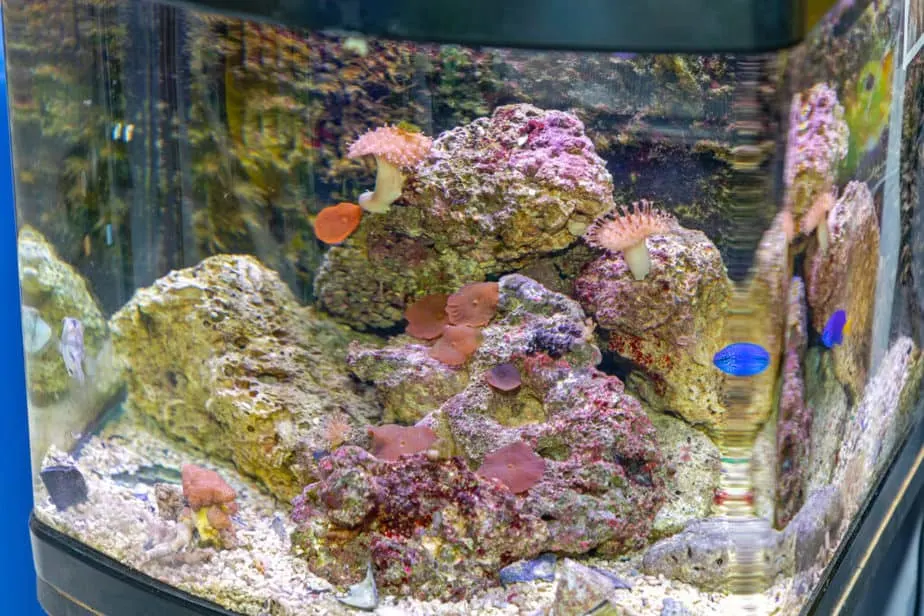
Rocks can be placed in different ways. They can be placed vertically, stacked together, or pieced together on the floor. Whatever way you place them will have an impact on the final outcome. Also, different corals require different rock placement patterns, more about that later.
Lighting is important to grow corals
Lighting is one of the most important aspects of growing coral in a reef tank. The corals you will be growing are photosynthetic which means they need light to make their own food, but that’s not all. The amount of light your lighting will provide during the daytime allows them to survive. Another reason why lighting is very important is that it directly influences the colors of the corals.
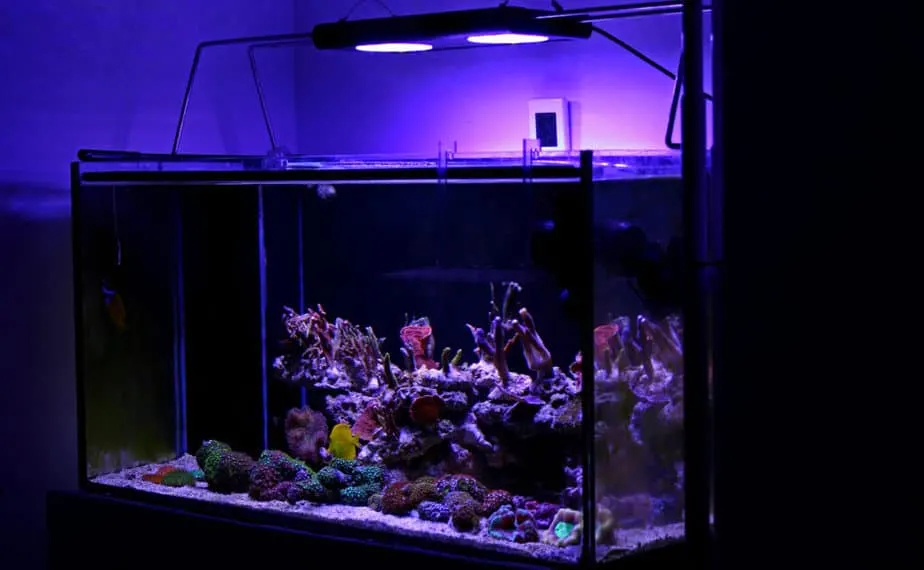
The units I’ll be using here are kelvins and PAR, which stands for Photosynthetically Active Radiation. Kelvin abbreviated as K and determines the position of the light in the electromagnetic spectrum. A higher value means the light is bluer, lower value means the light is more towards the warmer side. However, the intensity is inversely proportional. So, finding the sweet spot is paramount.
Corals that we can grow in our reef tanks at home are usually from deep sea so they thrive on bluer lights. Why is that? Because the blue light of the spectrum has the highest penetrating power. It essentially is the only color that reaches the depths of the corals because the other colors are filtered out. Usually, lights of 6500-7000k are known to yield the best results.
A common question is whether corals need white light to grow. The answer is no, and I’ve answered it in more detail here.
We will use PAR to determine the correct lighting strength/intensity in the tank. Soft Corals like zoanthids, mushrooms, etc. require around 50-150 PAR. Hard Corals like SPS (Small Polyp Stony) corals need 200-500 PAR. Large polyp stony (LPS) corals thrive at 50-150 PAR. The general rule of thumb is that hard corals need more light and soft corals need less.
Water Parameters for growing corals
Many aquarists consider water parameters the most important aspect of reef tanks and they are not wrong. Here are some of the most important water parameters that must be strictly maintained. I assure you that you’ll start to feel like a chemist when you get the hang of testing and adjusting the water parameters in your reef tank.
An aquarium must be ready for corals before you add them. I’ve answered a couple of questions that are essential to know before adding your first coral:
- Do corals need a cycled tank?
- When to add coral to a new reef tank?
- Can you add too many corals at once?
- How fast do coral frags grow in a reef tank?
- How to increase coral growth?
Alkalinity: If you haven’t skipped chemistry lectures, you know what alkalinity is. It’s the level of bicarbonate in the water. It is important for two reasons. One: it directly affects the pH and two: bicarbonate makes the coral skeleton. So, keeping an optimum bicarbonate level is important for your corals to grow. The ideal level is 8-12 dKH which is the degree of carbonate hardness.
Salinity: Salinity means the amount of salt in the tank water. If you are making your own saltwater, you should know the optimal salt level. If you purchase ready-made saltwater, make sure the proper level is maintained. Salt level influences the density of the water and how light rays behave inside the water.
As salt level influences the density, we can measure it by specific gravity. Usually, a specific gravity of 1.024 to 1.025 is considered ideal. You can measure the salinity of the water using a salinity refractometer such as this one (Amazon).
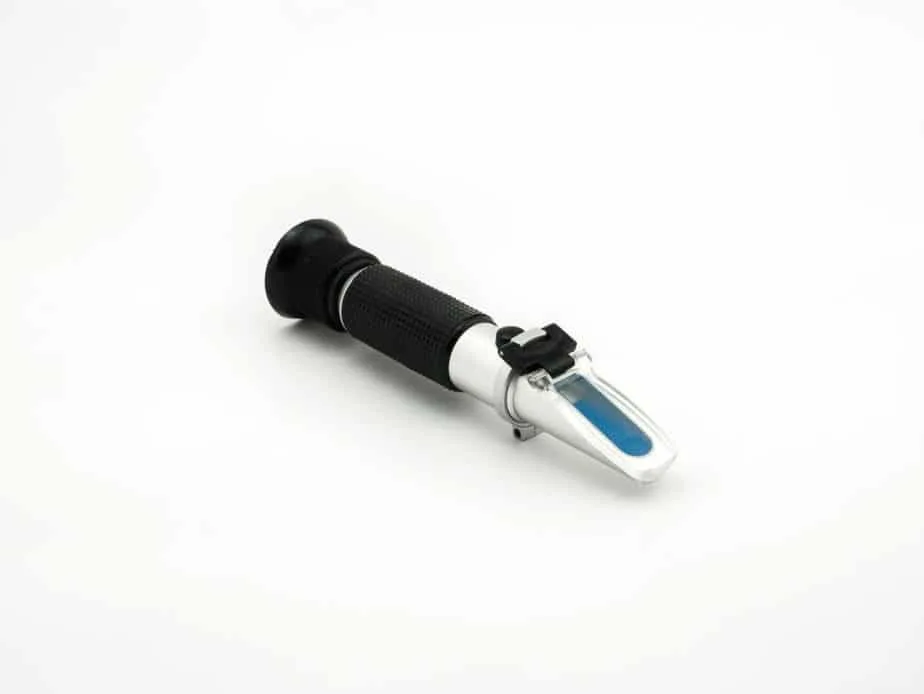
Calcium level: Calcium helps to make the skeleton of the coral. In the deep sea, they get the calcium from seawater. When growing at home, it’s your job to give what they need. The ideal calcium level is 350-400 ppm. You’ll need to add calcium to your reef tank, especially when you’re growing LPS or SPS corals.
Nitrate level: Nitrate is derived from the nitrogen wastes of the corals. Bacteria convert the nitrogen to nitrite after which they convert it into nitrate. A high level of nitrate might act as a fertilizer for the algae’s and grow them beyond limitation. As a result, the overall health of the corals shall start to deteriorate. As for the ideal level, the lower the better. Keep nitrates as low as you can.
Ammonia: Ammonia is produced from bodily wastes of fish and corals. It is very toxic and may burn the skins of any creatures in the tank. Any detectable level of ammonia is dreadful. Make sure the biological filters in your reef tank are working properly.
pH: pH indicates how acidic or how basic the water is. It is the negative logarithm of hydrogen ion concentration in the water and the middle point is 7. Anything less than 7 means the water is becoming acidic and more than 7 means the water is becoming alkaline. The ideal level of pH is 8 to 8.4.
Temperature: Most of the corals reside in the temperature range between 22-30 degrees Celsius. If the area you are in has a similar temperature, then it’s your lucky day. If not, you will have to maintain the temperature by artificial means. Read this page to learn more about the recommended temperature for different types of corals.
Water Flow and Movement
Water flow is very important and is often disregarded. Different species require different patterns of water flow for nutrient and aesthetic purposes. When in captivity, you need proper flow to distribute all the additives and nutrients around the aquarium. You can use a wavemaker, the outflow of your return pump, or powerhead to mimic the flows. Proper flow shall improve the quality of life of the corals and fishes.
Hard corals usually prefer high water flow while soft corals generally want slow water flow. Just remember that no coral-like still water. The bottom of the tank receives less water flow, so you can place soft corals there. But in the end, it all depends on the place of the motors, pumps, etc. so be discreet.
Characteristics of Beginner Friendly Corals
Keeping corals successfully, especially as a beginner, means that you have to choose the right coral species. Before we can discuss some suitable coral options, let’s talk about some of the requirements that make a specific type of coral easier than others.
Robust corals are easier
There’re are many different corals out there that can be difficult to keep because they are extremely picky. An example of this is Acripora, which one of the most difficult SPS corals out there to keep. They can die within hours is an aspect of your water parameters is off. This is not what you want, so choose wisely.
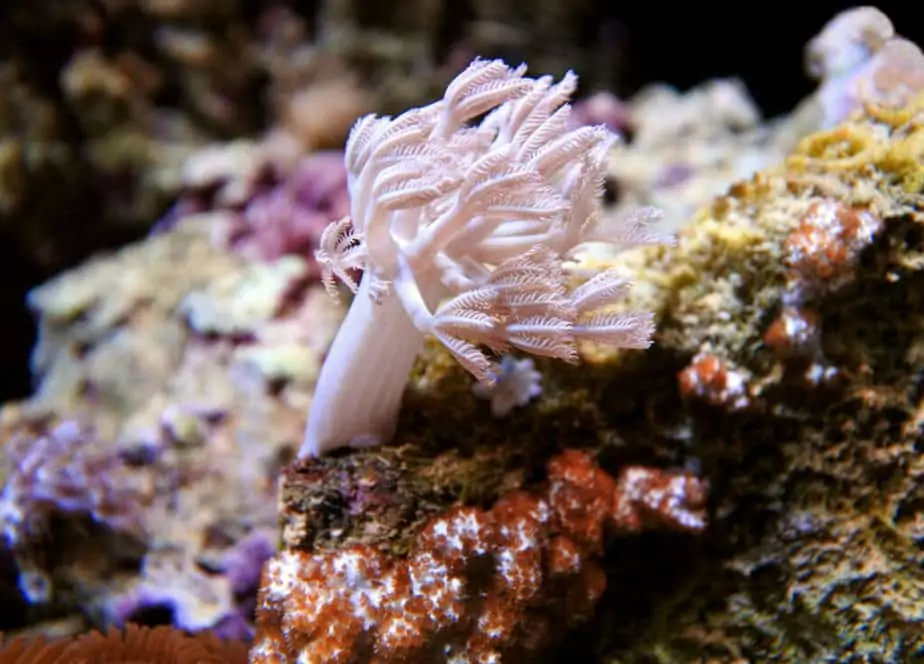
If you’re a beginner, the corals that you’re going to keep must be tough and strong. It takes a lot to adapt to the aquarium, this goes for fish but definitely also for corals. So, the corals you are trying to grow in your aquarium must be able to adapt well to their new conditions.
They shouldn’t be sensitive to minuscule changes in the tank. If they can take a beating they’ll allow for inconsistencies that are bound to happen if you’re just starting to keep corals.
Photosynthetic
Some coral types are photosynthetic and some are not. Most of the corals that we can keep in our reef tank are photosynthetic and can produce their own food.
All you need to do is to make sure the coral you are choosing is photosynthetic. Thus, you won’t have to worry about regular feeding. Just don’t forget it is possible to feed corals, and especially soft and larger polyped corals benefit from additional feeding. I recommend reading my article on feeding corals for more information.
Stick with common and popular corals
Don’t go around buying the most exotic looking coral in the market that no one knows. Choose a common species. Uncommon specimens are more likely to die quickly, hence they are low in numbers and not a lot of people are keeping them.
Plus, you will have a hard time finding the proper care sheet for the coral. Marine biologists and enthusiast aquarists may not know anything about it. You’ll make your life easier by sticking with common corals with known and tested requirements.
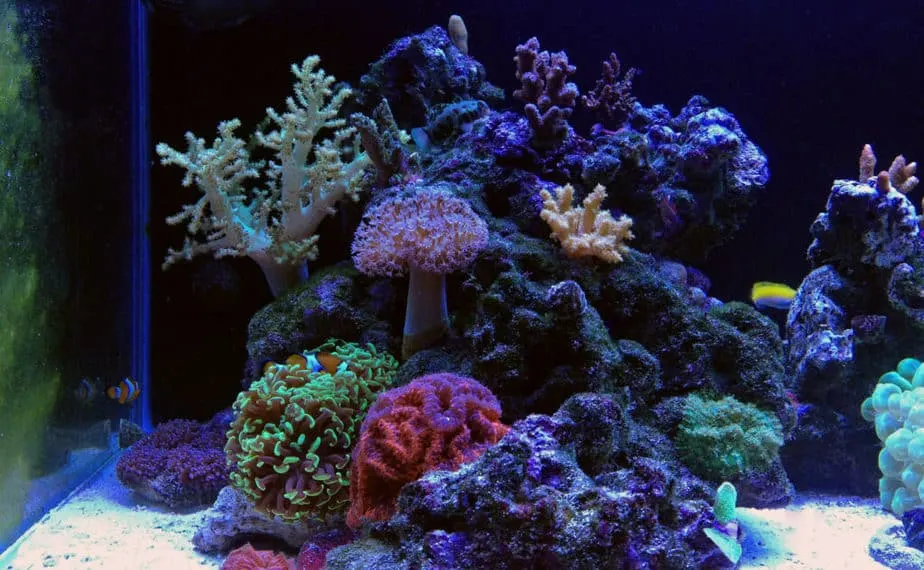
Resistant to disease
Look for a species that lives long in the sea. A long life-span means it can fight disease well. In the sea, corals are met with natural measures to fight disease conditions. In the aquarium, you are less likely to mimic the perfect marine environment. So, the more resistant the coral is, the more convenient it will be for you as a beginner.
Best Corals Species For Beginners
Next up is the moment we’ve been working towards. You know how to set up an environment suitable for growing corals with success. Let’s dive into some popular corals that I would recommend to every beginner out there! On this page I’m only covering 5, but I’ve also compiled a list of 15 stunning types of coral that are suitable for beginners. Make sure to check this one out later for more inspiration!
1. Toadstool Corals
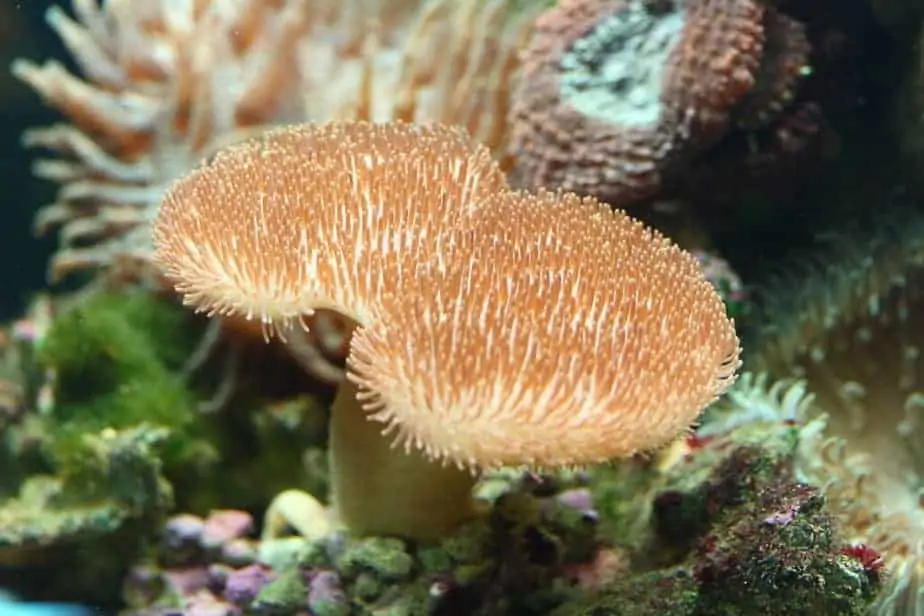
The first coral on this list is toadstool coral! They are named after toadstool mushrooms because, well, they closely resemble each other. This coral-group has several members like toadstool leathers or weeping willow toadstool. They need moderate lighting, can be placed anywhere and can make their food themselves. Toadstools tend to grow fast and become large so it’s smart to plan ahead.
The toadstool leather corals have polyps. Those polyps exhibit a nice, harmonic motion in the irregular current. This is a really nice view. The weeping willow toadstool coral as well as others grow very fast and use all the extra nutrients that might result from overfeeding or faulty filtration. Thus, it prevents toxicity for other corals in the tank
2. Mushroom Corals
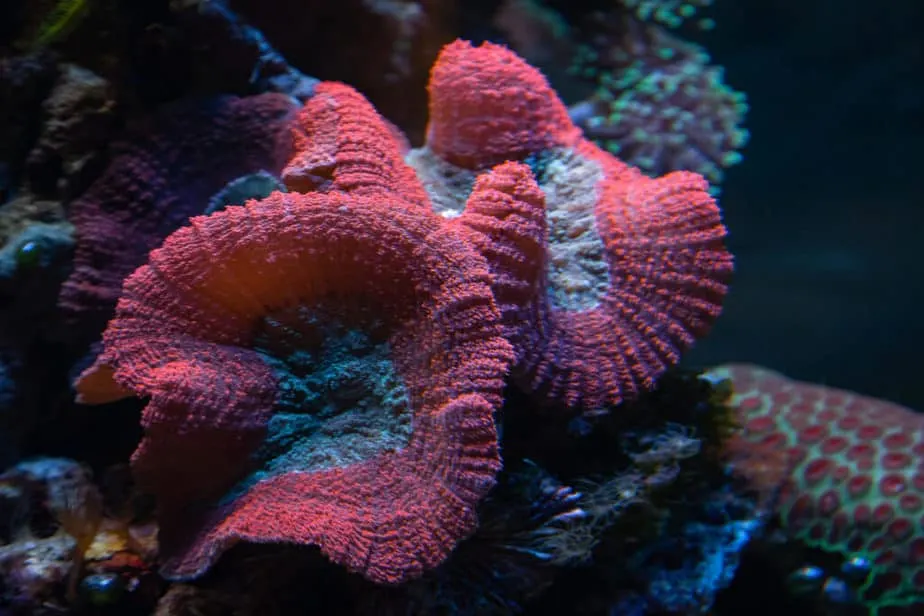
Next up are mushroom corals! Mushrooms are another very common type of coral that are widely chosen by reefers around the globe. These soft corals are probably the easiest to care for and grow. They are very affordable and offer a wide variety of flashy colors. They grow fast so you always have to keep an eye on them if you are planning to grow other species.
Mushroom corals actually prefer lower light and near-stagnant water. So, if you are reluctant to manage all the lighting, powerheads, wavemakers, etc. Mushrooms will be your best bet. They do photosynthesis, respond well to added foods, and are safe for all aquarium fish.
3. Pulsing Xenia Corals
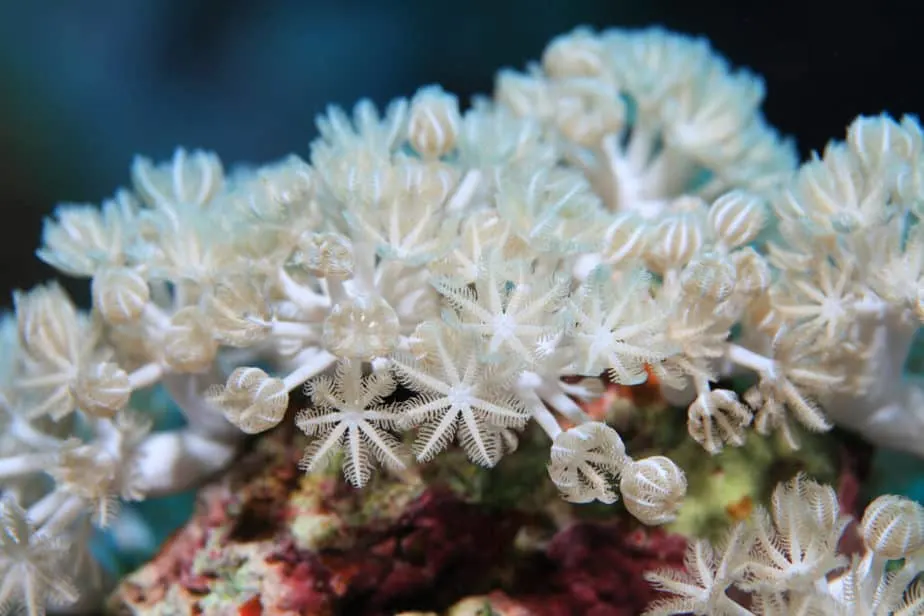
My personal favorite on the list is called Pulsing Xenia. Pulsing Xenia corals are one of the most beautiful and unique looking corals you could find on the market. They require minimal water parameters with low flow and light. Plus, they can adapt very well to tank environments. Pulsing Xenia corals are so beautiful that I can bet, even if they weren’t easy to grow, they would still be one of the top choices.
Any coral that offers any sort of rhythm in your tank is very much welcomed. The pulsing xenia is one step advanced when it comes to spontaneous movement. When in mild to low current, their tentacle-like polyps open and close like a human hand, resembling a pulsing movement. This gives the name pulsing xenia.
This is not something I can show in a picture so check out this short video! The polyps open and close by themselves!
4. Bubble Corals
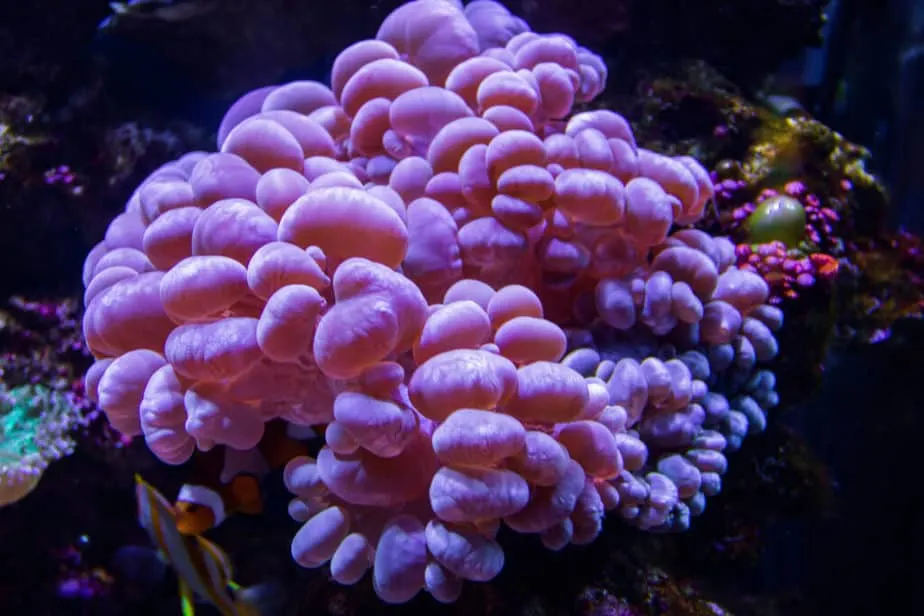
Bubble corals are very distinctive looking corals. They look like a cluster of bubbles, eggs, or white colored grapes whatever seems fit. Their unique look and easy maintenance is the reason why they’re preferred by many reefers.
They require low light, no food, and are very affordable. This makes it the best option if you are on a budget. They come in many different colors and look stunning: perfect beginner corals.
5. Zoanthids Corals
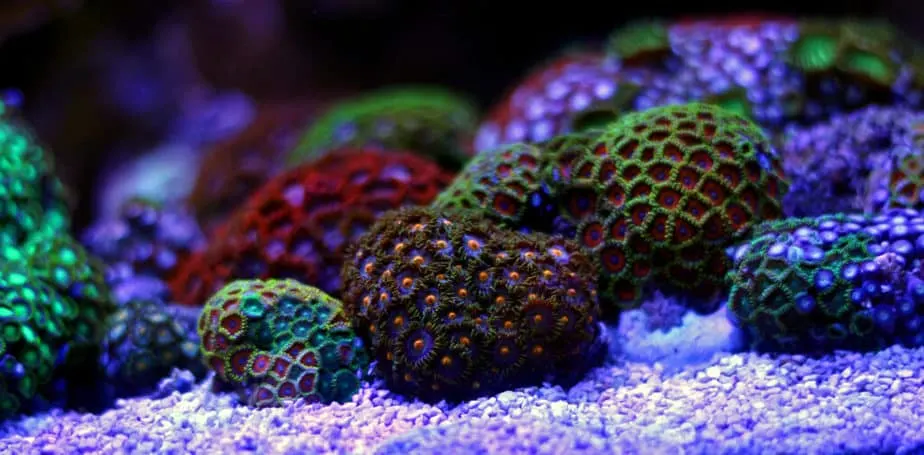
Zoanthids are the most popular corals for enthusiasts and hobbyists, but they can excrete a deadly poison. I’m going to include them on this list because they’re not dangerous as long as you know what you’re doing. If you end up choosing zoanthids for your reef, first read the article on my site called “How to handle corals” and continue with caution.
Many newbies often choose this species as their get-go. The reasons behind this are simple. They are easy to grow and maintain. Also, they are hardy so you won’t face any trouble as a beginner. Being one of the most common, there are tons of guides available online for care and maintenance.
They are very tolerant of different temperatures, water qualities, and other parameters. They are available in literally hundreds of different color varieties that are sure to attract any aquarists, be that a veteran or a newbie. They are photosynthetic, so no need to worry about proper, intense lighting and whatnot.
How to Place Corals Inside the Tank?
Coral placement requires skill and knowledge. You can’t just drop them in the tank. There are a few steps you must follow to place them in your tank the right way. Although coral placement requires practice, I’m sure you’ll do a great job after reading this section. I try to provide all info you should know.
Quarantine your corals (up to you)
As a beginner, you won’t be needing quarantine. But knowing about it is worth it. Quarantine shall come into play later when you will want to add more corals in your tank where there are other thriving and established corals. Any new coral might contain diseases, so the chances of infecting others are high.
By properly quarantining your corals, you minimize the risk of a new coral infecting already established corals. When starting a new tank, your first batch of corals will be “quarantines” together by immediately placing them in the final tank. If you want to add other corals later down the road, quarantining them first could be something to consider.
Using Dips to treat diseases
Dipping your corals is always advised as it will disinfect the corals from any unknown disease. Dipping a coral just means temporarily soaking it in a liquid. There are various dip solutions available in the market. I’ve written a more in depth guide on both how to dip corals, as well as what dipping solution to choose.
If you want to see an experienced reefer talk about dipping corals for beginners, I recommend watching the video from Mad Hatter’s Reef. I’ll like it below:
In short, this is how you dip your coral: In a bowl, mix the dip solution with the display tank water. Place the coral in the bowl and spray with some kind of sprayer. After that, rinse off the dip solution by using clean water from the tank. Now you are good to go.
Drip Acclimate your Coral
Drip acclimation is a must for any creature that you buy from the store to keep in a saltwater tank. It is the method of adjusting the temperature of the water bag with the water temperature of your aquarium. The method is simple. First, let the bag float for about 15 to 30 minutes in the tank. Then slowly add water from your tank to the bag using some sort of tubing.
Once you feel that the temperature is adjusted, carefully place the coral on the ground of the tank. By drip acclimating your corals you allow them to slowly get used to the new (and probably different) water parameters of your reef tank.
Correct Placement
Different corals need different placement. SPS corals prefer high water flow and intense light. So, place them as high as possible. But make sure they don’t breach the water surface. As for LPS corals, you can place them deep in the water as light and flow aren’t much of an issue for them. The same goes for soft corals, lower in the tank is fine as long as there’s still some flow present. Read my tutorial on how to place coral frags on live rocks, as this will come in handy with your first corals.
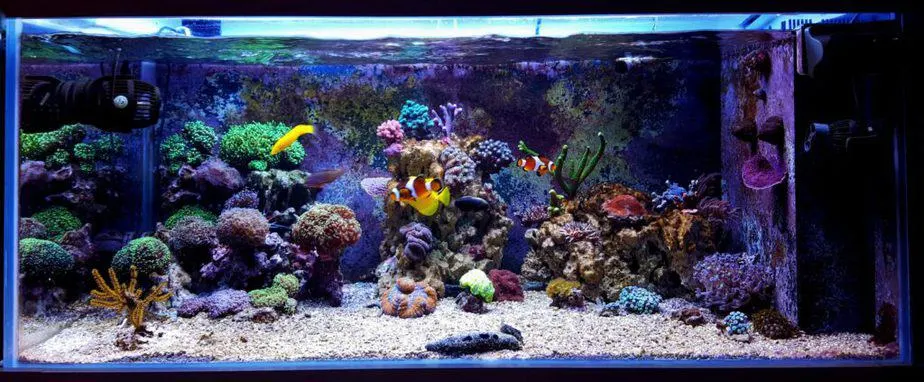
Care and Maintenance of Corals
Although the corals you are growing are photosynthetic, you can give supplemental food. In the ocean, they catch small animals called zooplankton. So, you can give them zooplanktons as food supplements as it will ensure proper nutrition. Other nutrients like phosphate and nitrates are also important (although you should keep those concentrations low).
Make sure to read my article called “Do corals need food” for a better explanation. I’ve also written a page that explains the best time to feed corals in your reef tank, which you can find here.
An excessive amount of these trace elements will cause the algae to penetrate the tissues of the coral, resulting in the destruction of the coral tissue. If the level is low, the algae will die and the coral will lose its coloration. Be sure to check every water parameter once a week, nitrate levels once every fourteen days, and phosphate levels every month.
Water should be changed frequently although the exact frequency is debated. Many aquarists emphasize changing the entire water every two weeks while some are more methodical, changing twenty percent of the water every week. And last but not least, keep your tank neat and clean.
Cautions with Corals
Corals are known to release a toxic substance called palytoxin. Although it is not lethally toxic, it’s always good to stay vigilant. You should take the following precautions when handling corals:
- Use eye goggles, gloves, and masks
- Slime like substances may squirt from an accidental cutting of corals. Be careful
- Don’t take corals close to sensitive organs like the eyes, nose, etc.
- Keep carbon nearby as they are the only medium of removing palytoxin from the tank
- Dispose of contaminated water in the proper place.
- If accidentally ingested or inhaled, consult a doctor immediately.
Final words on growing coral
Growing corals at home is hectic but also fun if you are aware of the know-hows. The lack of a proper beginner’s guide is enough to break your aspirations to be a reefer. Keeping that in mind, I have designed this article in a way so that you can find the most elemental pieces of knowledge about how to grow corals in a reef tank.
I have also mentioned some of the best corals for beginners and talked about how to choose the right coral for you. Buying the right tank can be confusing, so I haven’t ignored that either. Besides discussing fundamentals, I’ve also shed some light on some minor but important topics. This article should guide you to achieve all the masteries to grow coral at home.

